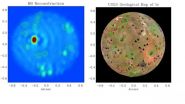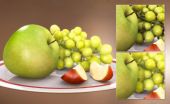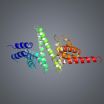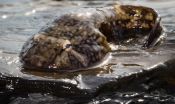First field-effect transistors on hybrid perovskites fabricated for first time
2015-05-05
(Winston-Salem, N.C. - May 5, 2015) - Researchers from Wake Forest University and the University of Utah are the first to successfully fabricate halide organic-inorganic hybrid perovskite field-effect transistors and measure their electrical characteristics at room temperature.
"We designed the structure of these field-effect transistors that allowed us to achieve electrostatic gating of these materials and determine directly their electrical properties," said lead author, Oana Jurchescu, an assistant professor of physics at Wake Forest. "Then we fabricated these transistors ...
Volcano Loki observed from Earth
2015-05-05
This news release is available in German.
With the first detailed observations of a lava lake on a moon of Jupiter, the Large Binocular Telescope Observatory in Arizona places itself as the forerunner of the next generation of Extremely Large Telescopes. The applied high-resolution imaging methods were developed by an international research team including scientists from the Max Planck Institute for Radio Astronomy in Bonn and the Max Planck Institute for Astronomy in Heidelberg.
Io, the innermost of the four moons of Jupiter discovered by Galileo in January ...
New methods for realistic surface rendering in computer games
2015-05-05
This news release is available in German.
Overturning cars, flying missiles, and airplanes speeding across the screen -- on modern computers, 3D objects can be calculated in a flash. However, many surfaces still look unnatural. Whether it is skin, stone or wax -- on the computer screen, all materials look alike, as if the objects had all been cut out of the same kind of opaque material. This is about to change: TU Wien (Vienna), the University of Zaragoza and the video game company Activision-Blizzard have developed a new mathematical method which makes surfaces appear ...
How our view of what makes us happy has changed in 80 years
2015-05-05
Our view of what makes us happy has changed markedly since 1938.
That is the conclusion of the psychologist Sandie McHugh from the Univeristy of Bolton who has recreated a famous study of happiness conducted in Bolton in 1938. She will present her study today, Tuesday 5 May 2015, to the Annual Conference of the British Psychological Society in Liverpool.
In 1938 Mass Observation placed an advertisement in the the Bolton Evening News asking readers to answer the question 'What is happiness?'. A total of 226 people sent letters in reply, and they were asked to help compile ...
'Freezing a bullet' to find clues to ribosome assembly process
2015-05-05
Ribosomes are vital to the function of all living cells. Using the genetic information from RNA, these large molecular complexes build proteins by linking amino acids together in a specific order. Scientists have known for more than half a century that these cellular machines are themselves made up of about 80 different proteins, called ribosomal proteins, along with several RNA molecules and that these components are added in a particular sequence to construct new ribosomes, but no one has known the mechanism that controls that process.
Now researchers from Caltech and ...
New centimeter-accurate GPS system could transform virtual reality and mobile devices
2015-05-05
AUSTIN, Texas -- Researchers in the Cockrell School of Engineering at The University of Texas at Austin have developed a centimeter-accurate GPS-based positioning system that could revolutionize geolocation on virtual reality headsets, cellphones and other technologies, making global positioning and orientation far more precise than what is currently available on a mobile device.
The researchers' new system could allow unmanned aerial vehicles to deliver packages to a specific spot on a consumer's back porch, enable collision avoidance technologies on cars and allow virtual ...
Changing attitudes about sex
2015-05-05
SAN DIEGO, Calif. (May 5, 2015)-- Acceptance of premarital sex is at an all-time high along with an acceptance of homosexuality, find researchers led by Jean M. Twenge from San Diego State University.
The researchers -- also including Ryne Sherman from Florida Atlantic University and Brooke E. Wells from Hunter College -- analyzed data from the General Social Survey, a nationally representative survey of more than 33,000 U.S. adults taken between 1972 and 2012. They found substantial generational shifts in attitudes toward non-marital sex and number of sexual partners. ...
Proteomics provides new leads into nerve regeneration
2015-05-05
Using proteomics techniques to study injured optic nerves, researchers at Boston Children's Hospital have identified previously unrecognized proteins and pathways involved in nerve regeneration. Adding back one of these proteins--the oncogene c-myc--they achieved unprecedented optic nerve regeneration in mice when combined with two other known strategies. The findings were published online April 30 by the journal Neuron.
Researchers have been trying for many decades to get injured nerves in the brain and spinal cord to regenerate. Various molecules have been targeted ...
Shedding light on rods
2015-05-05
"Imagine a tiny spotlight like those used in theatres but with a light ray measuring only a few nanometres, which shines light on a given spot but leaves everything else in the dark," explains Monica Mazzolini, SISSA research scientist, "That's how the optic fibres we used in our experiment work". Mazzolini, first author of a paper just published in PNAS, literally shut herself in a "darkroom" lit with infrared light only to stimulate rods, the light-sensitive cells of the retina (for night vision), with these extremely focused light beams in vitro. In their study, Mazzolini ...
Women hospitalized 60 percent more than men after emergency asthma treatment
2015-05-05
ARLINGTON HEIGHTS, Ill. (May 5, 2015) - While it may be a stereotype, it's also true that women seek medical care more frequently than men do. And a recent study shows that women with acute asthma who are treated in the emergency department (ED) are 60 percent more likely than men treated in the ED to need hospitalization.
The study, published in the Annals of Allergy, Asthma and Immunology, the scientific publication of the American College of Allergy, Asthma and Immunology (ACAAI), looked at the sex differences in patient characteristics, and risk of hospitalizations ...
Bystander CPR helps cardiac arrest survivors return to work
2015-05-04
DALLAS, May 4, 2015 -- More bystanders performing CPR contributed to more cardiac arrest survivors returning to work in a Danish study published in the American Heart Association journal Circulation.
In the largest study to date to examine return to work after cardiac arrest, researchers studied 4,354 patients in Denmark who were employed before they suffered out-of-hospital cardiac arrests between 2001 to 2011. Researchers found:
More than 75 percent of survivors who had a cardiac arrest outside a hospital were capable of returning to work.
Chances of returning ...
An unexpected role for calcium in controlling inflammation during chronic lung infection
2015-05-04
Many of us take a healthy immune system for granted. But for certain infants with rare, inherited mutations of certain genes, severe infection and death are stark consequences of their impaired immune responses.
Now, researchers at NYU Langone Medical Center have identified an important role for calcium signaling in immune responses to chronic infection resulting from Mycobacterium tuberculosis, the bacterium causing tuberculosis (TB).
Specifically, they determined that the immune systems in genetically altered mice lacking the critically important calcium channel ...
Primary care visits available to most uninsured, but at a high price
2015-05-04
Uninsured people don't have any more difficulty getting appointments with primary care doctors than those with insurance, but they get them at prices that are likely unaffordable to a typical uninsured person, according to new Johns Hopkins Bloomberg School of Public Health-led research.
And payment options are not very flexible, with only one in five people told they could be seen without paying the whole cost up front, suggests the new study published in the May issue of the journal Health Affairs.
"There's a discouragement factor for uninsured people when it comes ...
New screening technique could pick up twice as many women with ovarian cancer
2015-05-04
A new screening method can detect twice as many women with ovarian cancer as conventional strategies, according to the latest results from the largest trial of its kind led by UCL.
The method uses a statistical calculation to interpret changing levels in women's blood of a protein called CA125, which is linked to ovarian cancer. This gives a more accurate prediction of a woman's individual risk of developing cancer, compared to the conventional screening method which uses a fixed 'cut-off' point for CA125. The new method detected cancer in 86% of women with invasive epithelial ...
Racial differences in male breast cancer outcomes
2015-05-04
ATLANTA -- May 4, 2015 -- While black and white men under age 65 diagnosed with early-stage breast cancer received similar treatment, blacks had a 76% higher risk of death than whites, according to a new study. The study, published in the Journal of Clinical Oncology, found that the disparity was significantly reduced after accounting for differences in insurance and income.
Male breast cancer is a rare disease, accounting for less than 1% of all cancers in men and approximately 2% of all breast cancers in the United States. Black men have a higher incidence of breast ...
How oxidizing a heart 'brake' causes heart damage
2015-05-04
Oxidative stress has been long known to fuel disease, but how exactly it damages various organs has been challenging to sort out. Now scientists from Johns Hopkins say research in mice reveals why oxidation comes to be so corrosive to heart muscle.
A report on the results, published online May 4 in The Journal of Clinical Investigation, shows that oxidation inside the cardiac cells precipitates heart failure by disrupting the work of a heart-shielding protein called PKG, known to act as a natural "brake" against biological stressors like chronically elevated blood pressure, ...
Are scare tactics off the table for public health campaigns targeting HIV?
2015-05-04
Over the last ten years, public health campaigns in New York City around smoking, obesity, and HIV underwent a dramatic shift to use fear and disgust to spur behavior change, sometimes with the unintended consequence of stigmatizing affected populations. In a new article published in the May issue of the journal Health Affairs, scholars at Columbia University's Mailman School of Public Health explore the implications of this shift to fear-based campaigns in the present public health environment.
Beginning in 2005, the New York City Department of Health and Mental Hygiene ...
Green tea extract and exercise hinder progress of Alzheimer's disease in mice
2015-05-04
COLUMBIA, Mo. -- According to the National Institutes of Health (NIH), Alzheimer's disease (AD) may affect as many as 5.5 million Americans. Scientists currently are seeking treatments and therapies found in common foods that will help stave off the disease or prevent it completely. Now, University of Missouri researchers have determined that a compound found in green tea, and voluntary exercise, slows the progression of the disease in mice and may reverse its effects. Further study of the commonly found extract could lead to advancements in the treatment and prevention ...
Enhancing emergency medical care for seniors could reduce hospital admissions
2015-05-04
(NEW YORK - May 4) Applying palliative care principles to emergency departments may reduce the number of geriatric patients admitted to intensive care units, possibly extending lives and reducing Medicare costs, according to a three-year analysis by Mount Sinai researchers set to be published in the May edition of Health Affairs, which can be found online.
"Data show that more than half of Americans ages 65 and older are seen in the emergency department in the last month of their lives, and that the number and rate of admissions to intensive care units among older adults ...
'Fuzzy thinking' in depression & bipolar disorder: New research finds effect is real
2015-05-04
ANN ARBOR, Mich. -- People with depression or bipolar disorder often feel their thinking ability has gotten "fuzzy", or less sharp than before their symptoms began. Now, researchers have shown in a very large study that effect is indeed real - and rooted in brain activity differences that show up on advanced brain scans.
What's more, the results add to the mounting evidence that these conditions both fall on a spectrum of mood disorders, rather than being completely unrelated. That could transform the way doctors and patients think about, diagnose and treat them.
In ...
Premature birth alters brain connections
2015-05-04
Premature birth can alter the connectivity between key areas of the brain, according to a new study led by King's College London. The findings should help researchers to better understand why premature birth is linked to a greater risk of neurodevelopmental problems, including autistic spectrum disorders and attention deficit disorders.
The NIHR-funded study, published in the journal PNAS, used functional magnetic resonance imaging (fMRI) to look at specific connections in the brains of 66 infants, 47 of whom were born before 33 weeks and were therefore at high risk ...
Pitt team follows zinc to uncover pathway that fine-tunes brain signaling
2015-05-04
PITTSBURGH, May 4, 2015 -- A study team led by researchers at the University of Pittsburgh School of Medicine who used specially developed technologies to "follow the zinc" have uncovered a previously unknown pathway the brain uses to fine-tune neural signaling -- and that may play a role in Alzheimer's and other diseases. Their findings appear online this week in the Proceedings of the National Academy of Sciences.
Scientists have long observed the presence of bubble-like vesicles that contain the neurotransmitter glutamate and zinc at the synapses, specialized contacts ...
Virginia Tech researcher shines light on origin of bioluminescence
2015-05-04
In the mountains of Virginia, millipedes have bright yellow and black colors to warn enemies that they are toxic and not worth eating. Their cousins in California convey this warning in a very different way -- by glowing in the dark.
But bioluminescence at least in one millipede may have evolved as a way to survive in a hot, dry environment, not as a means to ward off predators, according to scientists publishing this week (Monday, May 4) in the Proceedings of the National Academy of Sciences.
The discovery, based on a millipede that hadn't been seen in 50 years, shows ...
May 2015 Gastrointestinal Endoscopy highlights
2015-05-04
DOWNERS GROVE, Ill. - May 4, 2015 - The May issue of GIE: Gastrointestinal Endoscopy, the monthly peer-reviewed scientific journal of the American Society for Gastrointestinal Endoscopy (ASGE), features a meta-analysis pointing to botulinum toxin A as a possible obesity treatment; a study reporting that, in some cases, it may be safe to store endoscopes longer than five days after reprocessing; and an article reviewing a promising group of procedures for patients with advanced illness from gastric obstruction.
"Effect of intragastric injection of botulinum toxin A for ...
Puget Sound's clingfish could inspire better medical devices, whale tags
2015-05-04
Scooting around in the shallow, coastal waters of Puget Sound is one of the world's best suction cups.
It's called the Northern clingfish, and its small, finger-sized body uses suction forces to hold up to 150 times its own body weight. These fish actually hold on better to rough surfaces than to smooth ones, putting to shame industrial suction devices that give way with the slightest uneven surface.
Researchers at the University of Washington's Friday Harbor Laboratories on San Juan Island are studying this quirky little fish to understand how it can summon such massive ...
[1] ... [2892]
[2893]
[2894]
[2895]
[2896]
[2897]
[2898]
[2899]
2900
[2901]
[2902]
[2903]
[2904]
[2905]
[2906]
[2907]
[2908]
... [8720]
Press-News.org - Free Press Release Distribution service.




